
From albert gate, BACK TO LAMBETH: Alternative route through BELGRAVIA, PIMLICO & WESTMINSTER

HYDE PARK CÓRNER and GREEN PARK Stas.

Buses alongside PICCADILLY, KNIGHTSBRIDGE and PARK LANE

LandOwners of belgravia?
Eaton hall

The Grosvenor family came to England with William the Conqueror, and have held land in Cheshire since that time. In the seventeenth century Sir Thomas Grosvenor third baronet married Mary Davies a London heiress. Her dowry was part of the manor of Ebury, the land developed by their successors as Mayfair in the eighteenth century, followed by Belgravia and Pimlico in the nineteenth century.
A family of great hunters

Talbot dogs introduced to this country by the Normans as hunting dogs. Now extinct, they were the ancestral stock of the modern bloodhound. Talbot dogs were added to the Grosvenor coat of arms in the seventeenth century. The gold wheatsheaf, known in heraldry as a 'garb' appeared for the first time on the coat of arms in 1398.
GROSVENOR is a name formed by two French words: GROS (great) and VENEUR (hunter).
Builders of belgravia
George basevi

Thomas cundy

Albert gate

Impregnable!. The soon-to-be dethroned “Railway King”, aka George Hudson, bought one of the two houses. That purchase is slightly of interest as the house had stood empty for a while after it was completed and had gained the nickname of Gibraltar, under the belief that it would never be taken.
William street

Shops and eateries
Lowndes square
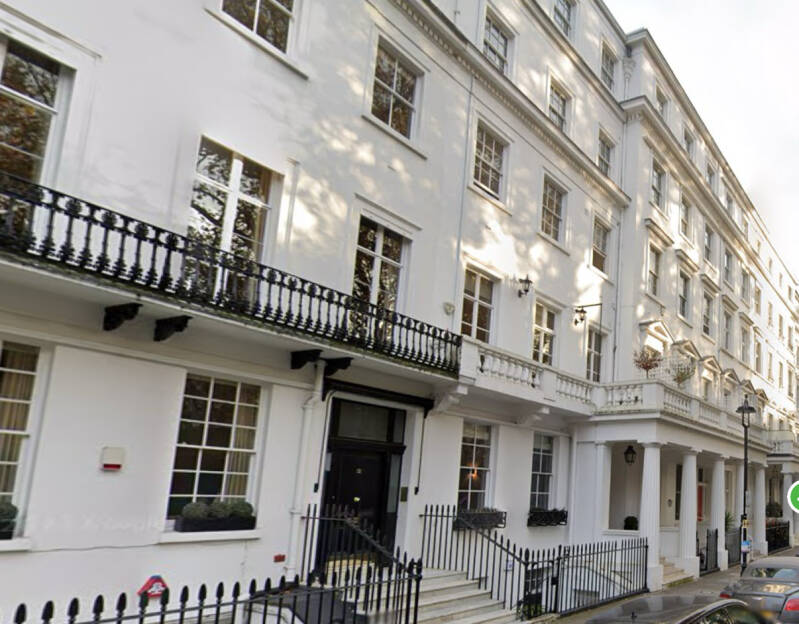
Duke of wellington

Grandson of the first Duke. Inherited the title and estates when his childless brother died in 1900. A serving officer of the Grenadier Guards rising through the ranks from Ensign to Colonel but he never saw active service, his duties being mainly ceremonial. Died Ewhurst Park, Basingstoke, with great timing - on Waterloo Day.
Lowndes street

Shops and eateries
Halkin arcade

Shops and eateries
Motcomb street


Originally the name of a large establishment here, in Motcomb Street, opened in May 1831. It combined a picture gallery, a furniture shop, and the sale of carriages, while its southern half was a sizeable warehouse for storing furniture and other items. Seth Smith, whose family were originally from Wiltshire, was a builder/property developer in the early 19th century, and constructed much of the new housing in Belgravia, then a country area. Their clients, the dwellers of the new district, required storage facilities and this was built on an awkward left-over triangular site with a façade of Greek style Doric columns and was called Pantechnicon, pseudo-Greek for "pertaining to all the arts or crafts".
Subsequently, special wagons were designed with sloping ramps to more easily load furniture, with this building name on the side. The very large, distinctive horse-drawn vans that were used to collect and deliver the customers' furniture came to be known as "pantechnicon vans". From around 1900, the name was shortened to simply "pantechnicon". The Pantechnicon Ltd, a furniture storage and removal company, continued to trade until the 1970s.
The lord tennyson ph


Keep Exploring this area of belgravia
Kinnerton mews
The nag’s head ph

The wilton arms ph

wilton crescent
Lord mountbatten, a very british coup…
The last viceroy of India

Was Lord Mountbatten approached by Cecil King about overthrowing the government?. According to THE CROWN, shortly after Mountbatten's forced retirement, he was approached by a group plotting to unseat Prime Minister Harold Wilson. The Crown's Mountbatten warms quickly to the proposal—particularly to the idea of installing himself in 10 Downing Street.
The real story, however, is much less black-and-white. "Well, I think [Mountbatten] took it more seriously than he later claimed, and there was a bit of a cover-up, but I find it hard to think that he would have gone much further," Andrew Lownie, author of The Mountbattens: Their Lives and Loves, told Town & Country. (The cover-up would come later, in 1975, when Hugh Cudlipp included a meeting with Mountbatten and others on the matter in his memoirs. Naturally, this caused a stir, and Mountbatten did his best to quell suspicions surrounding these revelations.)
The berkeley Hotel

St.paul’s Church
The church was founded in 1843, the first in London to champion the ideals of the Oxford Movement, during the incumbency of the Rev. W. J. E. Bennett. The architect was Thomas Cundy the younger.[2]

The grenadier ph.
The Grenadier is a public house in Belgravia, London. It was originally built in 1720 as the officers' mess for the senior infantry regiment of the British army, the 1st Regiment of Foot Guards, and located in a courtyard of their barracks. It was opened to the public in 1818 as The Guardsman,and subsequently renamed in honour of the Grenadier Guards' actions in the Battle of Waterloo.[1]
Old barrack yard

A former PRESBYTARIAN church, First converted into a private house. Now, a private dinning club
The first virtual non-profit cultural centre registered in the United Kingdom. The MCC promotes and divulges Mexican culture in international collaboration with academic, artistic, and cultural projects.
Belgrave mews west
Belgrave square


Former DoWNSHIRE house, now no.24

In 1907 Chairman and Managing Director of the WHITE STAR LINE, Joseph Bruce ISMAY and his wife Florence arrived for dinner at the Belgrave Square home of Lord PIRRIE and his wife Margaret. William James Pirrie was managing director of the HARLAND & WOLF SHIPYARD in Belfast. Ismay was the Managing Director of the White Star Line, one of Britain's most pre-eminent shipping companies, and since 1902 part of the International Mercantile Marine.
Today, no 24 Belgrave Square, formerly known as Downshire House, serves as the London home of the Spanish embassy; historically Downshire House is recognised as a significant landmark, as the place where the story of the Titanic began.
Canning house
Canning House has worked to build understanding and relationships between the United Kingdom, Latin America and Iberia since 1943.
George Canning was Foreign Secretary from 1807 – 1809 and again from 1822 – 1827, which were crucial times in the Wars of Independence which took place in Latin America from the first uprisings in Argentina in 1810 to the recognition of Uruguay in 1828.
Canning saw the advantages of British support for the emerging republics, partly to counter-balance the United States with its Monroe Doctrine in 1823 and partly to maintain a political balance in Europe following the Napoleonic Wars.
Referring to this, in one of his most famous quotations, Canning declared: "I called the New World into existence, to redress the balance of the Old."
The Grosvenor family came to England with William the Conqueror, and have held land in Cheshire since that time. In the seventeenth century Sir Thomas Grosvenor third baronet married Mary Davies a London heiress. Her dowry was part of the manor of Ebury, the land developed by their successors as Mayfair in the eighteenth century, followed by Belgravia and Pimlico in the nineteenth century.
conquerors & liberators
King Henrique of postugal, “the navigator”
His patronage of exploration resulted in the discovery of the Azores and the Madeira and Cape Verde Islands. Died at Sagres.

Columbus
First European journey to America, on behalf of the Castilian crown
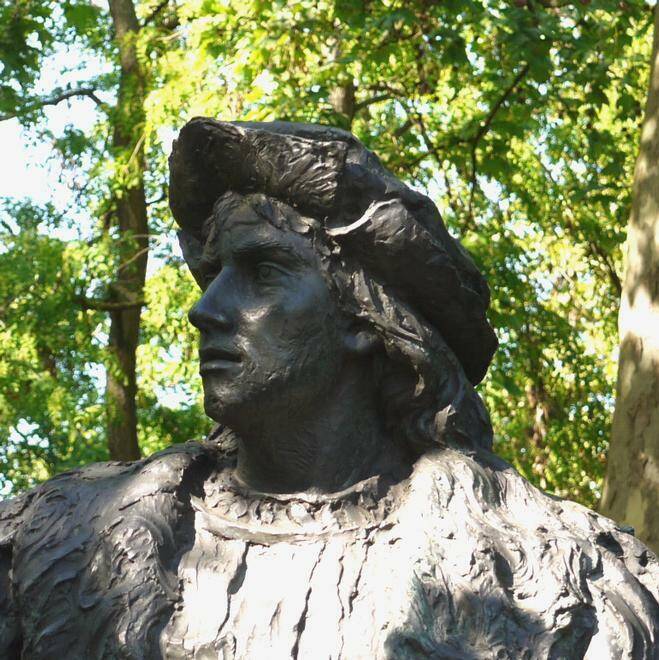
San martin


Bolivar

Italian cultural institute
The Italian Cultural Institute of London, the official body of the Italian State, aims to promote and improve awareness of the Italian language and culture in Great Britain through the organization of cultural events to promote the circulation of ideas, arts and sciences.



See the wealth of memorial plaques that you will find in the area
Upper belgrave st.
Lord lucan, disappeared…
One of the most infamous murders of the 20th Century was committed in a house on the corner of Eaton Square and Lower Belgrave Street when Richard John Bingham, more commonly known as Lord Lucan, murdered his family nanny Sandra Rivett and brutally attacked his estranged wife Veronica. Lady Lucan managed to escape while her husband was cleaning the blood from his hands in the bathroom.Keep reading
Eaton pl.
A film location: No.65
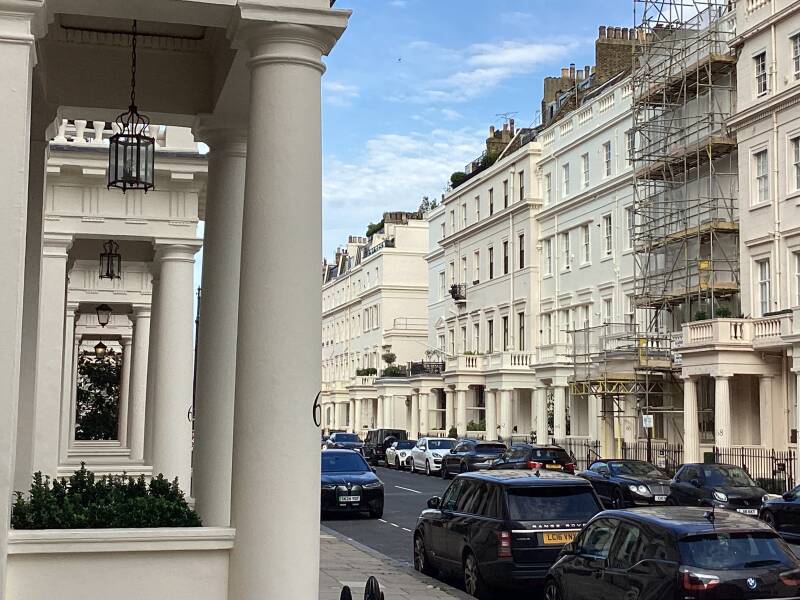
Award-winning British television classic series Upstairs, Downstairs. shown in the 1970s.
The residence of the President of the Republic of Poland, known as "The Castle", was first located in Bryanston Court at 56 Great Cumberland Place and then here at 43 Eaton Place.

Mathematical physicist and engineer. Born Belfast. His family moved to Glasgow when he was aged 11. Worked in thermodynamics and on the transatlantic cable. 1st Baron Kelvin. Died Largs Ayrshire.
Eaton sq.

Chester sq.
Dutch exile

Following the German invasion of the Netherlands in 1940, Wilhelmina fled to Britain and took charge of the Dutch government-in-exile. She frequently spoke to the nation over radio and came to be regarded as a symbol of the resistance.
St.michael’s church

Elizabeth st.


Eateries (and a chemist, just in case)
Shops and eateries
Former Eccleston Place Power Station, owned by Westminster Electric Supply Corporation Ltd. whom supplied electricity to the Mayfair & Belgravia area for the first time in 1891.The yard was redeveloped from a car park to a co-working and creative hub in 2018; part of a £1 billion investment program for the Belgravia area.
Victoria coach station

Victoria Coach Station is the largest and most significant coach station in London, and is operated by Victoria Coach Station Ltd., an arm of Transport for London serves long distance coach services. Victoria Coach Station was opened at its present site in Buckingham Palace Road, London, in 1932, by London Coastal Coaches Limited, an association of coach operators. The building is in a distinctive Art Deco style, the architects for which were Wallis, Gilbert and Partners.
Buckingham palace road
Library
On the map I pointed out the VICTORIA COACH STATION






Former empire terminal. imperial airways
The clue that the building once had a rather more significant transport role is in the sculpture over the main entrance, by the artist Eric Broadbent, which shows winged figures over the world. It’s entirely apt because when it opened in 1939 this building was the Empire Terminal, headquarters and passenger check-in for Imperial Airways.The Empire Terminal was ideally placed to serve both CROYDON AIRPORT and the flying boat docks, SOUTHAMPTON. Even in later decades, after the flying boat service ceased (in 1950) and Croydon Airport closed (in 1959) the Empire Terminal continued in use. Victoria station offered direct rail services to Gatwick Airport, while specially designed bus and coaches with luggage holds that had a customs seal facility, offered comfortable and convenient links to other airports too.
Elizabeth bridge

Pimlico
PIMLICO, in purple, not anymore part of the GROSVENOR ESTATE
And you do not need a passport to enter the district
st.george’s drive
Hugh street
Hugh Mews and Hugh Street – after Hugh Grosvenor, 1st Duke of Westminster, whose family owned much of the surrounding land (Hugh was a common name in the family)

The wildermere hotel

Eccleston sq.

Eccleston Square and Eccleston Square Mews are in land which was formerly part of the Grosvenor family estate; and they owned land in Eccleston, Cheshire, which explains the names of those thoroughfares
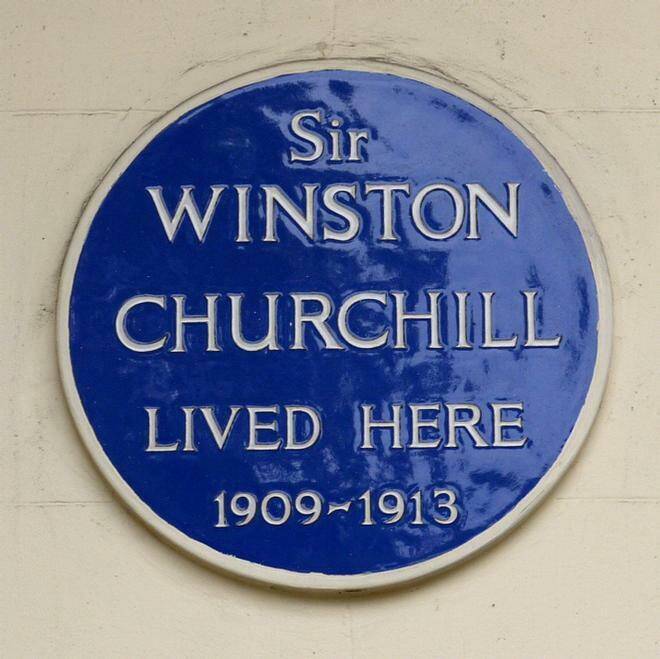
The young Winston moved into the 4,000sq ft flat a year after marrying Clementine Hozier and the first two of their children were born there — Diana in 1909 and Randolph in 1911. He lived here until 1913. And later for two years between 1916-1918. LIBERAL PM ASQUITH had appointed him as President of the Board of Trade.Aged 33, Churchill was the youngest Cabinet member since 1866. In February 1910, Churchill was promoted to Home Secretary, giving him control over the police and prison services. In October 1911, Asquith appointed Churchill First Lord of the Admiralty,[151] and he took up official residence at Admiralty House. As First Lord, Churchill was tasked with overseeing Britain's naval effort when the First World War began in August 1914
In October 1916, Asquith resigned as prime minister and was succeeded by Lloyd George who, in May 1917, sent Churchill to inspect the French war effort.[194] In July, Churchill was appointed Minister of Munitions. In January 1919, Lloyd George moved Churchill to the War Office as both Secretary of State for War and Secretary of State for Air. By the way, he could fly a plane!.
cambridge street
Dress designer and interior decorator. Born Laura Mountney at 31 Station Terrace, Dowlais, near Merthyr Tydfil. She married Bernard Ashley in 1949 and they began designing and printing tea towels and scarves. Gradually they expanded the business, eventually having retail outlets in four continents. She died in Coventry hospital following a fall at her daughter's home.
In October 2020, it was announced that Laura Ashley would return with a flagship store in the Westfield Shopping Centre in West London in 2021 through Next's 500 UK stores & website, and with a series of new stores.
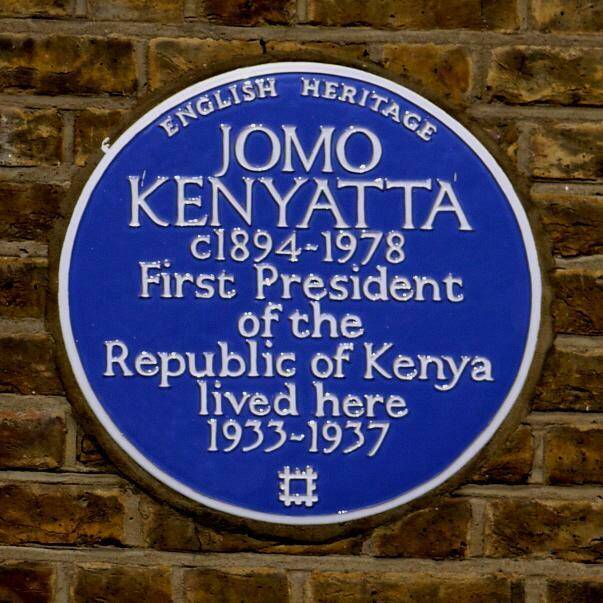
JOMO KENYATTA was the first President of the Republic of Kenya and the leader of its independence movement. He is commemorated with a blue plaque at 95 Cambridge Street, Pimlico, where he stayed for a short spell in 1930 and for a further four years in 1933–7.
Warwick sq.
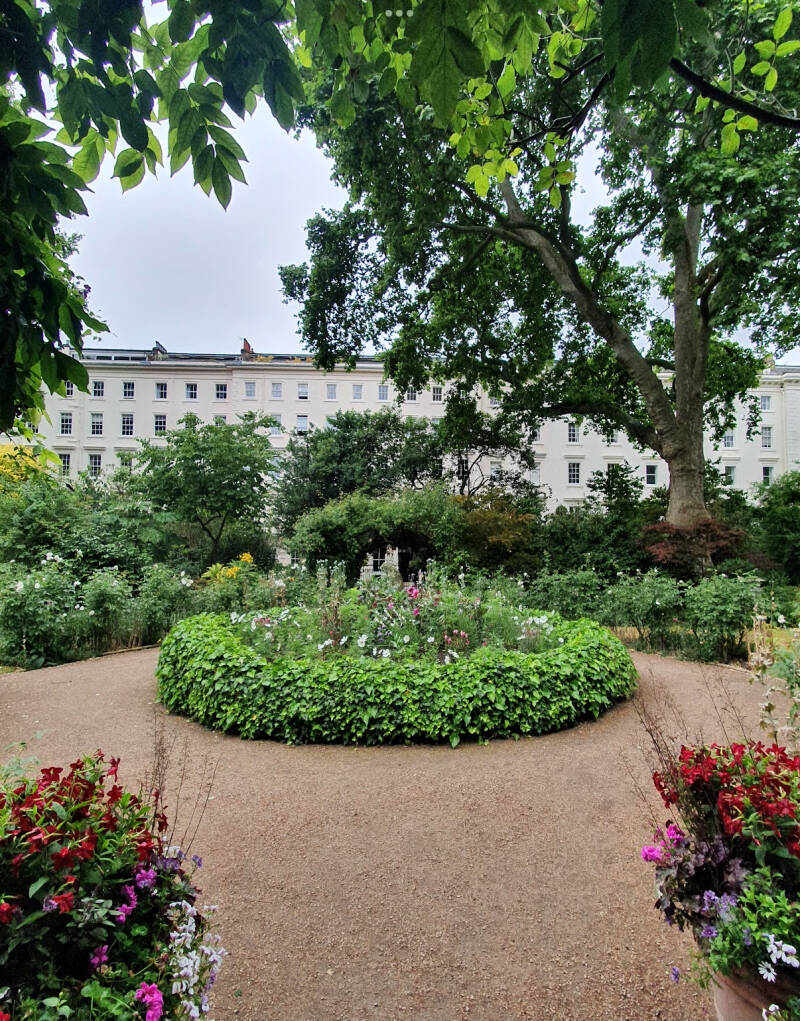
After Henry Wise, local 18th century landowner and gardener to William III, who owned land in Warwickshire
St.gabriel’s church
Built in the period of the 1820’s – 50’s by the architect Thomas Cundy at the direction of the 2nd Marquis of Westminster, Richard Grosvenor. The new estate was designed to rival Mayfair and extended into the marshland of PIMLICO. To serve the new estates Cundy designed the churches of ST.PAUL, KNIGHTSBRIDGE>>>>, <<<<ST.MICHAEL, Chester Square and the Pimlico churches of ST.GABRIEL, ST.BARNABAS and ST.SAVIOUR.
The parish of St. Gabriel was taken out of one of the wards of St George, Hanover Square, our mother church with whom it continues to have a supportive relationship. The church was built by subscription, with the £5,000 given by the Marquis as the lead donation. An Act of 1850 made financial provisions for the new building and on the 12th May, 1853 it was consecrated for divine worship by the Rt Rev’d Charles Blomfield, Bishop of London.
No.33 warwick sq.

Mansion and studio. 1860 to 1866. Architect George Morgan. Red , yellow and grey brickwork; pitched slate roof to eaves. Eclectic manner, irregular composition with canted corner to junction of Warwick Square and St George's Drive. Entrance in single storeyed stucco wing to left on St George's Drive. Two storey corner block with lower two storey, three bay wing to right to Warwick Square. Ground floor largely blind. Segmental-headed sash windows to upper floor. Interior contains decorations in C18 manner.
Born Narendranath Datta, was an Indian Hindu monk, philosopher, author, religious teacher, and the chief disciple of the Indian mystic Ramakrishna.[4][5] He was a key figure in the introduction of Vedanta and Yoga to the Western world,and is the father of modern Indian nationalism who is credited with raising interfaith awareness and bringing Hinduism to the status of a major world religion in the late nineteenth century.
Charlwood st.
Charlwood Place and Charlwood Street – after Henry Wise, local 18th century landowner and gardener to William III, who owned land in Charlwood, Surrey[12]
Market gardeners acquired land and built homes in Pimlico dubbed Neat Houses. The ‘Neat House Gardens’ behind them were osier beds and market gardens, named after the former Manor of Neyte, which covered about 100 acres and grew various vegetables and fruits. This low-lying, flood-prone area was primarily pastureland until the 16th century, sparsely populated by farmers tending livestock.
Henry Wise, Royal Gardener to Queen Anne, had gardens at Neat Houses.
Belgrave road
Belgrave is a historic village in Cheshire, England. The area is part of the estates owned the Dukes of Westminster who have their seat at Eaton Hall, Cheshire.
Tachbrook st
Lillington estate

The estate was among the last of the high-density public housing schemes built in London during the postwar period and is referred to as one of the most distinguished.
St.james’s the less church


St James the Less was built in the late 1850s by three sisters, Jane, Penelope and Mary, to honour the memory of their father, Bishop James Henry Monk. The parish of St James was a poor area, housing about 31,000 people in a collection of slums and tenements. The Monk sisters acquired land from Westminster Abbey and commissioned George Edmund Street as the architect, who was later to design the Law Courts (in London, on the Strand) and Bristol Cathedral.This parish church was built in 1858–61, designed by George Edmund Street in the Gothic Revival style.
Vauxhall bridge rd.
Westminster
Originally a small, secluded island on the marshy banks of the Thames?
The generally accepted boundaries of the district of WESTMINSTER (as different from the CITY OF WESTMINSTER) are: the Mall and Northumberland Avenue to the north, the river Thames and Victoria Embankment/Millbank to the east, Vauxhall Bridge Road to the south and Buckingham Gate, Buckingham Palace Road and Bressenden Place to the west.
Bloomburg st.
Named after Dr Blomberg, Domestic Chaplain to George IV
Vincent sq.
Westminster school, an english public school
Playing fields
Under-school
Westminster school, beside westminster abbey
Headmaster vincent
In 1802, the noted scholar and theologian, William Vincent took up the role. He was a vocal critic of republicanism and gave a number of notorious speeches which were often reprinted for wider distribution. Unfortunately for the Westminster schoolboys, he was also a strong believer in corporal punishment and was well known for his bellow of Eloquere, puer, eloquere (Speak out boy!) on the classrooms.
In 1810, noting that the fields to the south of modern day Victoria Street, known as Tothill Fields were slowly being taken over by housing developments — the legend goes that he paid a farmer with a horse to plough a ditch around a large square in the marshland areas to secure it for the school before anyone else could claim it.
Former children’s hospital and nurses home


These swaddled babies have their inspiration in work by Della Robbia. His bambini were installed on the Ospedale degli Innocenti (Hospital of the Innocents) in 1487 in Florence and the image of a swaddled baby has since become a symbol of paediatrics.
Former police station, redeveloped as apart
A statue of the Greek god, Priapus, protector of gardens, fruit plants, livestock… and male genitals. Often shown with a giant phallus, here in Pimlico, such a brazen display has however been curtailed in favour of his more earthly attributes.This is the Pimlico Priapus, by the Scottish sculptor, Alexander Stoddart and was installed in 2007 as part of the public art commission for the post-modern style block of flats behind.
5b BACK TO LAMBETH: Alternative route through BELGRAVIA, PIMLICO & WESTMINSTER
Former students residence, now a hotel

Former hospital


Over 100 years ago a small group of luminaries from the hospitality sector, including Auguste Escoffier, the most famous chef of his era, and the hotelier Cesar Ritz, were worried about the lack of young people in London qualified to work in catering establishments.
Sound familiar? They decided to do something about it. With the help of money from heiress Baroness Angela Burdett-Coutts, who had a special interest in the field, they came together to develop a school for professional cookery.
And you can eat here!
London Ritzy hotels, by the two…CROOKS
Savoy
Ritz and Escoffier are responsible for the establishment of modern superior hotels.
Yet they took advatage of their positions at the Savoy Hotel in London. Ritz and Escoffier, as well as Ritz’s deputy, Louis Echenard, collected e.g. 5% of every food purchase, made the food providers give them produce for free, etc. On March 7, 1898, the hotel, where Ritz was the general manager, dismissed them for larceny, embezzlement, and fraud. To avoid a lawsuit, Ritz and Echenard eventually agreed to repay a total of £4,173, and Escoffier £8000, which he did not have. These were enormous amounts of money. By way of comparison, the hotel's total profits that year had been £20,276. Yet they did not think they had done anything wrong, since they had made the Savoy a resounding success. They actually thought they deserved their share of the rewards; it was only fair!
CarltoN
Ritz
Nearby
Westminster Almshouses foundation

In 1656, Rev. James Palmer provided housing for six poor men and women, together with a school for the education of twenty boys. Later, he persuaded Nicholas Butler to bequeath his property in order to build ‘two, or three more houses’; and in 1674 also encouraged Emery Hill to donate yet more.
In 1708 twelve houses were built in Tuttle Fields on land leased from Westminster Abbey.With the redevelopment of Westminster, all properties were consolidated on the site of Emery Hill's almshouses in Rochester Row, becoming the United Westminster Almshouses in 1879, from when many of the present buildings date.
St.stephen’s church, rochester row

Former. Police station & court, redeveloped
Royal horticultural society library




An Area called long time ago tothill fields…
Tothill Fields was an area of Westminster that lay south of St James's Park. "Tothill Fields," says Archer, in his Vestiges of Old London "were, within three centuries, part of a marshy tract of land lying between Millbank and Westminster Abbey, and on which stood a few scattered buildings, some of them the residences of noble personages."
One of its main features was the TOTHILL FIELDS BRIDEWELL PENITENTIARY. This was one of the less severe places of incarceration in the capital, as one of the main punishments was not being allowed to talk to other prisoners. Following demolition, its foundations were reused for WESTMINSTER CATHEDRAL which now occupies the site.
Otherwise, Tothill was a vast expense of semi-bog, notable in the history of British sport.
Between 1735 and 1752, an area was cleared to become the home venue of the Westminster Cricket Club. The earliest known match there was in August 1735, when Westminster defeated London by 3 wickets.
Tothill Fields is one of many places listed in History of the British Turf where horseracing had been organised and taken place. This ceased after 1798.
Market gardeners acquired land and built homes in Pimlico dubbed Neat Houses. The ‘Neat House Gardens’ behind them were osier beds and market gardens, named after the former Manor of Neyte, which covered about 100 acres and grew various vegetables and fruits. This low-lying, flood-prone area was primarily pastureland until the 16th century, sparsely populated by farmers tending livestock.
Commercial market gardening emerged in the 16th century as communities grew. Following the dissolution of religious houses, residents sought new sources of fresh produce.
Henry Wise, Royal Gardener to Queen Anne, had gardens at Neat Houses. Many gardeners were tenants, farming small plots.
Regency st.
Regency café
Opened here in 1946, this popular place has been voted as one of best eating place in London
The cafe is designed in an art deco style. Interior decorations include photographs of Tottenham Hotspur football players, walls tiling is original but the tables are new and formica topped.
The cafe has been featured as a filming location in several BBC series such as Judge John Deed , Rescue Me and London Spy. It has also appeared in the films Layer Cake and Brighton Rock as well as Pride.
Vincent st
Lcc social housing
The first, facing Regency Street and Page Street were commenced in 1902 and were considered of sufficient significance for the Prince of Wales (the future King GEORGE V) to ceremonially lay the foundation stone in 1903.

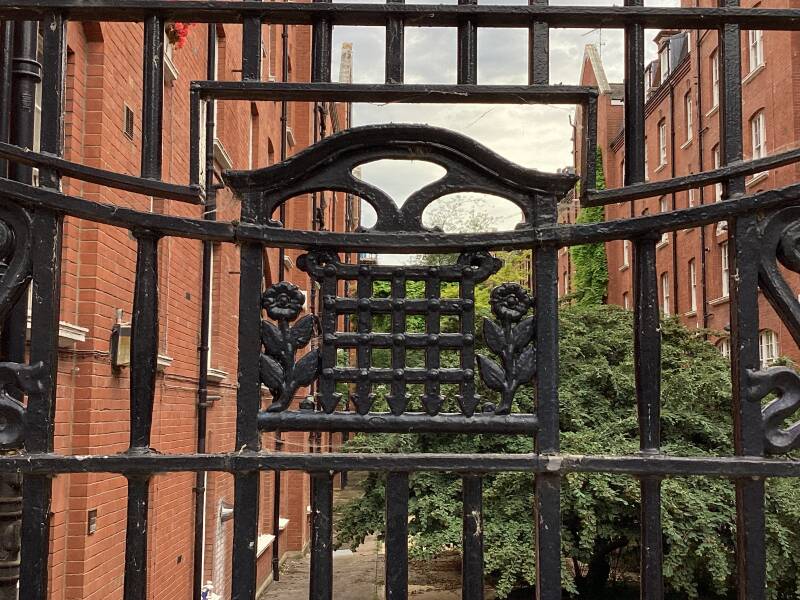


Grosvenor estate Social housing (edwin lutyens)

The second phase were designed by Sir Edwin Lutyens who was commissioned as consultant to the Grosvenor Estate, freeholder of the land, who granted a 999-year lease to Westminster and donated £120,000 towards the cost, provided the site was used for "housing for the working class," as part of the Westminster Housing Scheme. The flats have a conventional tenement plan and have striking and unusual chess-board facades of rectangles in buff-grey brick and rendered panels, covering the entirety of their outer facades.
Former children welfare centre

The City of Westminster Health Society was founded in 1903 by a collection of doctors and philanthropists, among them was Margaret Horn who was a pupil of iconic social reformer Octavia Hill. During that time the mortality rate of infants in the heart of the capital was appalling – almost 12% of children did not live to their first birthday. There were hardly any healthcare facilities available to families living in such extreme poverty.
The Society soon expanded its activities and established Medical Inspection Centres and its own training scheme. Other activities included Mothercraft and cookery classes, needlework classes, dental inspections and antenatal clinics. Since the second world war the emphasis of the Society's work has gradually changed and today it is primarily concerned with Toddler's Clubs and nurseries. As a result of this, in 1977, the City of Westminster Health Society changed its name to the Westminster Children's Society; a title which more accurately reflects its modern work.
millbank estate
The Millbank Estate (SW1P 4HP) was built between 1897 and 1902 by the London County Council to rehouse Londoners displaced by the building of Kingsway.
The Grade II-listed estate, located directly behind the Tate Britain, is regarded as a masterpiece of Arts and Crafts design. Its handsome seven-storey brick blocks are arranged around austere pedestrian courtyards.
The estate is now owned by Westminster Council. Many of the units were purchased by tenants under Right to Buy and private flats now change hands for up to £1 million.
Bulinga st?
This area was originally an area of marshland known as Bulinga Fen, originally marshland., which was reclaimed by the Benedictine monks who built and owned Westminster Abbey, and used it as a kitchen garden and fairground.
Corner od Bulinga st, and john islip st.: On this site, in the post-war period…
Prototypes of prefabricated houses,
a photograph showing prefabricated houses sited on the ground next to the gallery (picture 5 above; these prefabs were where Tate’s 1979 North East Quadrant extension now stands - the part covered in Ivy).
These were the prototypes for the 160,000 prefabs built after WWII, designed to address the post-war housing shortage. No.1, the house on the corner with the smoking chimney was the first. Despite Churchill’s announcement that factories would soon be churning out these houses, they never went into production and this steel clad structure - the show house - was built entirely by hand.
Tate britain

The national collection of British art
High tides

In the early hours of the 7 January 1928 the River Thames flooded. Bursting its banks at Lambeth, the force of the water demolished a stretch of the parapet wall 50 metres long. It left 14 people dead and an estimated 4,000 people homeless across London.
Site of Millbank prison

Originally constructed as the National Penitentiary, and which for part of its history served as a holding facility for convicted prisoners before they were transported to Australia. It was opened in 1816 and closed in 1890.The site at Millbank was originally purchased in 1799 from the Marquess of Salisbury for £12,000 by the philosopher Jeremy Bentham, acting on behalf of the Crown, for the erection of his proposed panopticon prison
Jeremy bentham
Former Royal army medical college , Now university of the arts-london



Standing opposite Tate Britain on the west side of Atterbury Street is Chelsea College of Arts. The college started life in 1895 as one of the schools of South-Western Polytechnic (which actually was in Chelsea). In 1908 this merged with the Hammersmith School of Art to form the Chelsea School of Art. The school was renamed Chelsea College of Art and Design in 1989 and then acquired its present name in 2013. It only took over the site here on Millbank in 2005, the buildings having originally been built to house the Royal Army Medical College in 1907. Prior to that, Millbank Prison had occupied the site of both the college and Tate Britain for around 80 years. Amongst its alumni Chelsea includes Anish Kapoor, Steve McQueen, Chris Ofili and Mark Wallinger.
Millbank
A watermill owned by WESTMINSTER ABBEY stood at a site close to present day College Green. Norden's survey, taken during the reign of Elizabeth I in 1573, records the existence of such a mill
Poms Down under

The bollard originally stood at the head of the river steps opposite Millbank Prison on the site of which the Royal Army Medical College was built and from where until 1867 prisoners sentenced to transportation embarked on their journey to Australia.
One of the (many) supposed origins of the word 'POM' for an Englishman, is that convicts were branded with the initials of 'Prisoner of Millbank'.
26th January is the official national day of Australia and marks the arrival of the First Fleet of British ships and the raising of the Union flag at Sydney Cove. The fleet included six ships transporting around 1,000 convicts…
“In honour of Admiral Arthur Phillip R.N., Citizen of London, founder and first governor of Australia. Born in the ward of Bread Street 11th October 1738. Entered the Royal Navy 1753 and died 31st August 1814.
To his indomitable courage, prophetic vision, forbearance, faith, inspiration and wisdom was due the success of the first settlement in Australia at Sydney on Saturday 26th January 1788”.
Not much was known South of Asia, so when explorers discovered Australia, they coined it “Down Under.” The reasoning is simple: the location was unknown, and located in the Southern Hemisphere, below most known countries. Australia is under the equator, another factor contributing to the nickname.
Prisoners might be taken through vaults and tunnels on board the barges. Some believe prisoners nicknamed this procedure “going down under” which in turn led to the popular colloquial term for Australia. Although other sources suggest prisoners were marched above ground via the prison’s main gate,
Not all of them criminals…
6 Dorset farm labourers, transported to Australia for joining a trade union. Following mass protests against their treatment the government was forced to give pardons and eventually after 2 years, all returned home. Five of them continued their campaign and supported the Chartists.
millbank

Now, after tate britAin, Two alternatives crossings to lambeth. First: over lambeth bridge
millbank tower
Completed in 1963 for Vickers and was therefore originally known as VICKERS HOUSE (or TOWER).as London’s tallest building, was one of the first buildings to rise above St Paul’s Cathedral in the capital. Millbank was the base for The LABOUR Party’s 1997 general election campaign “Operation Victory”, and then later became the headquarters of The CONSERVATIVE Party. The building also previously provided offices to the United Nations and was even used a preferred location for the filming of the BBC’s iconic series Doctor Who.
The tower has been owned by David and Simon Reuben since 2002, Redevelopment is planned for a hotel, apartments and eateries
Along Thorney st. Thorney island?
An island formed when the TYBURN RIVER - now lost among the submerged sewers - met with the THAMES forming a delta on which WESTMINSTER and the PALACE OF WESTMINSTER now reside… It is a seriously historic island.
Or is it ? A new edition of the celebrated book "The Lost Rivers of London", points out that no reliable maps existed before the seventeenth century…Keep reading.
Originally built in 1929-30 as offices for chemical giant, ICI, Thames House has since 1994 been the home of the UK Internal Security Service, more popularly known as MI5.
Burberry’s hq

This 1930s art deco building was completely refurbished in 2008.
THOMAS BURBERRY invents gabardine, in 1887. a lightweight, breathable, weatherproof and tearproof cloth. Its genius comes from the small pockets of air which allow for ventilation.
Norwegian polar explorer, zoologist and later recipient of the Nobel Peace Prize Dr Fritjof NANSEN becomes the first recorded polar explorer to take Burberry gabardine to the poles when he sets sail for the Arctic Circle in 1893.
Explorer Major F.G. JACKSON, famed for mapping parts of the Arctic Circle, wears Burberry gabardine when undertaking an expedition to Franz Josef Land, in 1897.
Celebrated aviator Claude GRAHAM-WHITE wears Burberry gabardine when he becomes the first person to fly between London and Manchester in less than 24 hours (1910).
Norwegian Explorer Roald AMUNDSEN and his team becomes the first people to reach the South Pole with a Burberry gabardine tent and clothing.
British Explorer Captain Robert FALCON SCOTT reaches the South Pole, wearing Burberry clothing and equipped with a Burberry tent. Tragically, he and his team lost their lives on the return journey.

A small extension before crossing lambeth bridge
Horse ferry road
Finally, in 1862, the Horse Ferry was replaced by Lambeth Bridge. Horse Ferry then ceased to operate, but its memory has been preserved by a road that today bears the name Horseferry Road.
dean bRadley st.
5b BACK TO LAMBETH: Alternative route through BELGRAVIA, PIMLICO & WESTMINSTER
Dean of Westminster 1881-1902
Smith square
St.john’s church
Lord north st.
Public shelters
Thomas fowell buxton memorial
A Rodin Artwork
PANkHURST memorial
Victoria tower gardens
Former i.c.i, now 9 millbank, residential
security services
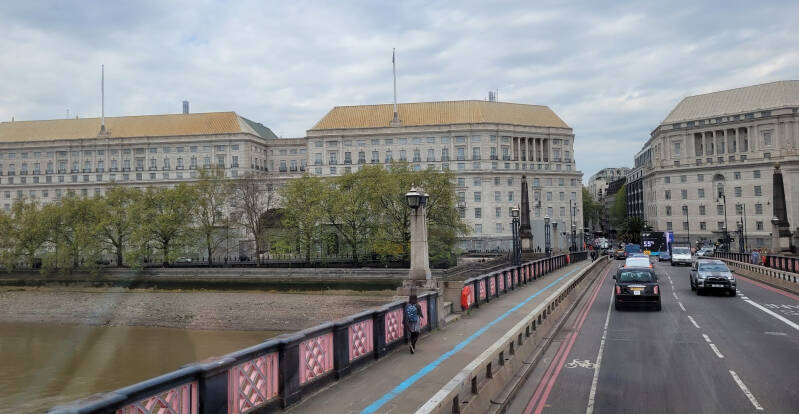


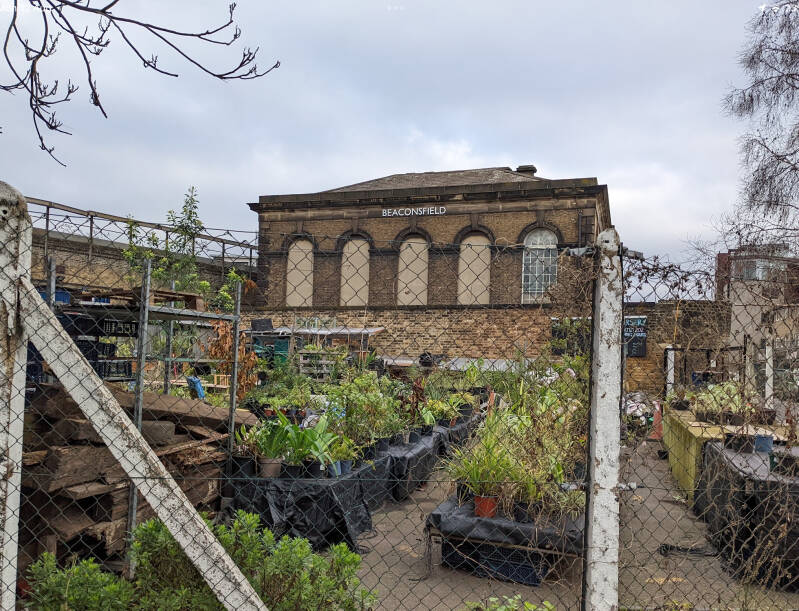
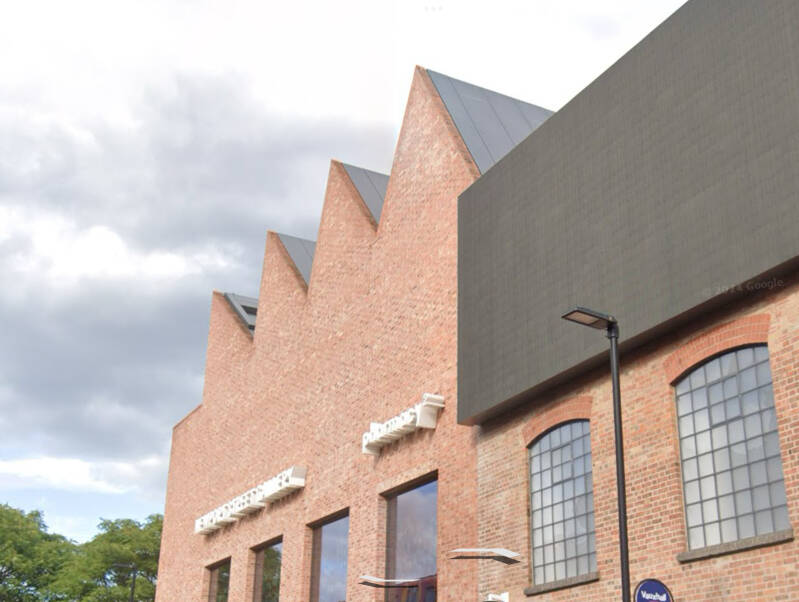


Second option: Towards vauxhall bridge
The morpeth arms ph
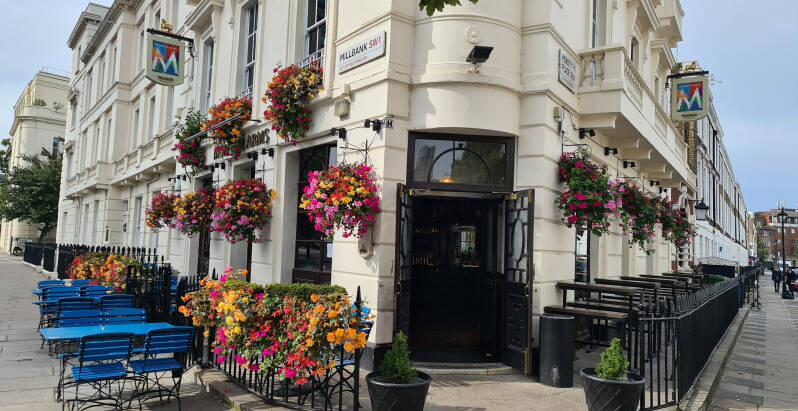
Legend has it that a network of vaults beneath the building are the remains of an old service tunnel (haunted by a former inmate, naturally), used to escort prisoners from the gaol to the riverbank for their departure Going . Down Under…
riverside walk gardens
vauxhall bridge and its ALLEGORICAL STATUES















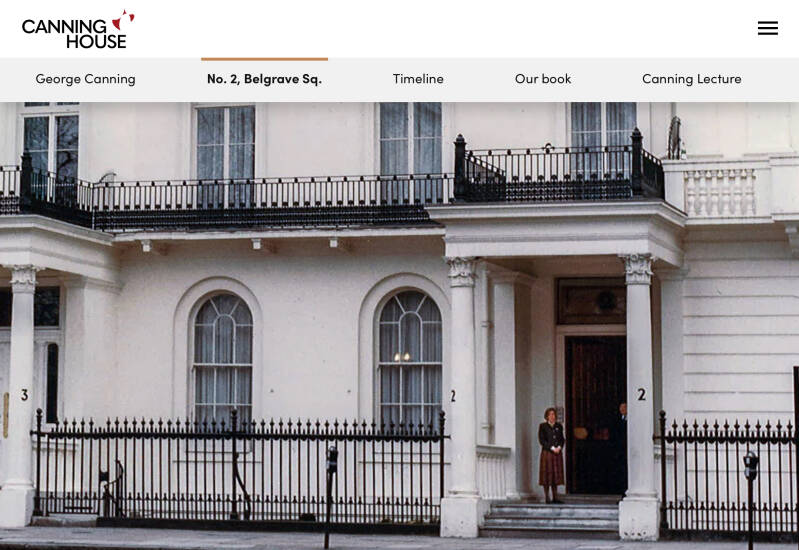










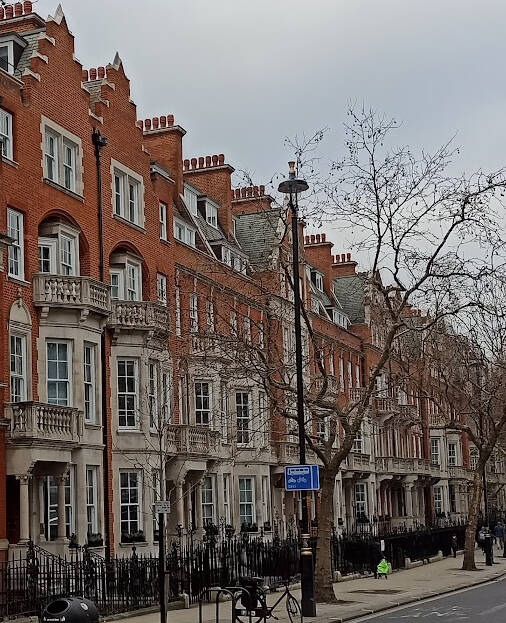





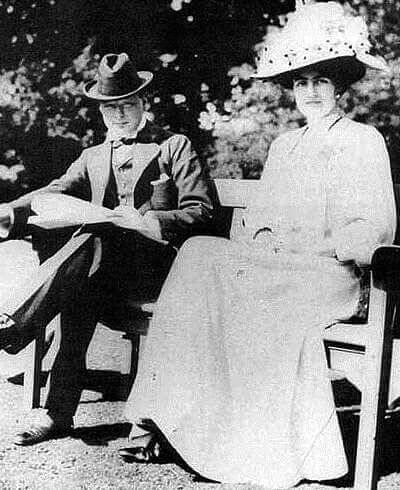




































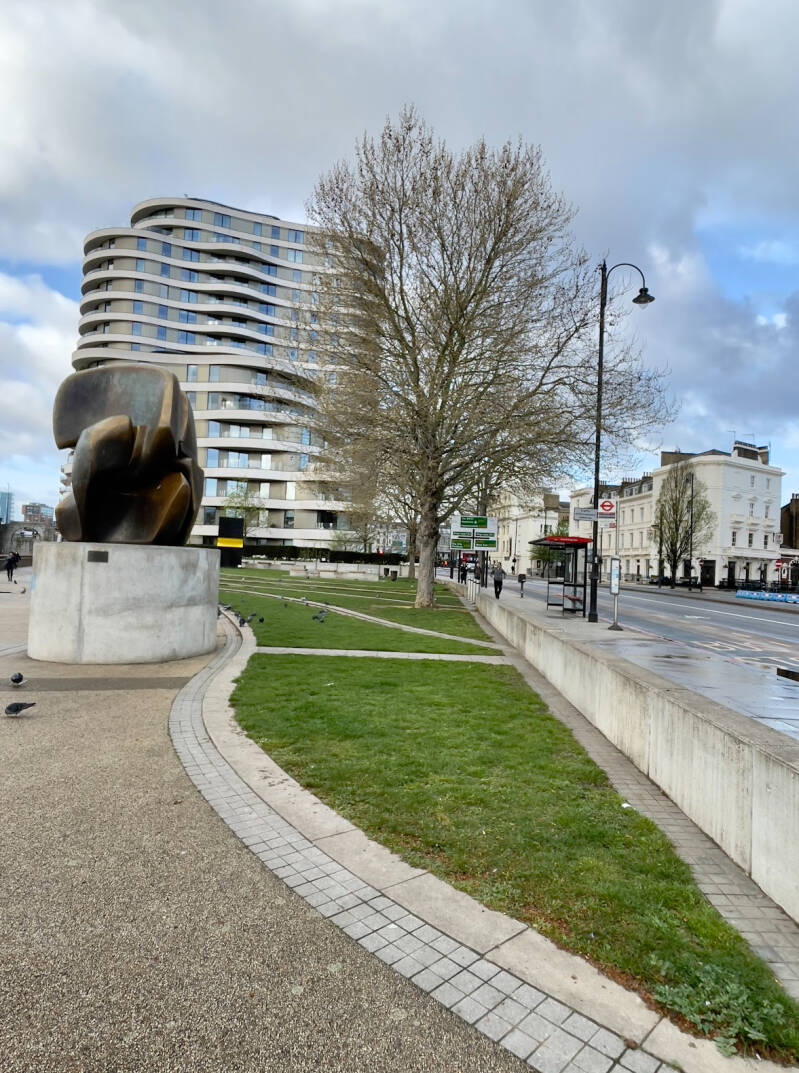

Create Your Own Website With Webador